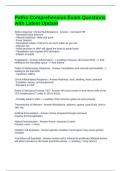Patho Comprehensive Exam Questions
with Latest Update
Stress response: Clinical Manifestations - Answer-- Increased HR
- Narrowed pulse pressure
- Altered breathing-- deep and quick
- Fever (sepsis)
- Decreased output-- hold on to as much water as you can
- Altered LOC
- Initial decrease in MAP will signal the heart to pump faster
- Vasodilation aslo signals SNS activation
- Dilation of pupils
Anaplylactic - Answer-Inflammation --> swelling of tissues; decreased MAP --> fluid
shifting to the interstitial space --> fluid edema
Patho of Inflammatory Response - Answer-Vasodilation and vascular permeability -->
leading to the fluid shift
- Cytokines, WBCs
CM of Inflammatory Response - Answer-Redness, heat, swelling, fever, purlurant
- Exudates: serous, serosanguinous
- Elevation in CRP
Patho of Infectious Process: HIV - Answer-HIV virus comes in and infects cells of the
CD4 lymphocytes (T cells) [< 200 is AIDs]
- Possibly leads to AIDs --> inability of the immune system to work properly
Transmission of infection - Answer-Bloodborne, airborne, spores, body fliuds, skin to
skin, etc.
Artificial Immunization - Answer-Active (acquired through vaccines)
Passive (immunoglobulin)
Natural Immunization - Answer-Active: exposure to toxin
Passive: mom --> fetus
Initiation cell dysplasia - Answer-genetic mutation "carcinogens may cause genetic
mutation
Promotion cell dysplasia - Answer-mutant cell is induced to proliferate (lifestyle factors
will either increase or decrease promotion phase --> smoking = lung cancer)
,Progression cell dysplasia - Answer-cells aquire properties that allow malignant
behavior --> metastasize
CM of Acute Myeloid Lymphoma - Answer-Bone pain, anemia, thrombocytopenia,
increased infections susceptibility
Vascular dilation and increased blood flow - Answer-cause erythema and warmth
edema - Answer-Extravasation and deposition of plasma fluid and proteins
Site of Injury - Answer-Leukocyte emigration and accumulation occurs
HIV 1 - Answer-most aids cases found in US
HIV 2 - Answer-Found mostly only in West Africa; longer latency with lower mortality
Etiology of HIV - Answer-gains access to CD4 cells by attaching to the CD4 receptor on
the cell surface; just because one is exposed does not mean that they will develop HIV
or AIDS
What progresses to AIDS? - Answer-RNA retrovirus that causes defect in cell-mediated
immunity that may progress to AIDS
Patho of AIDS - Answer-high level of virion and level of CD4+ cell death, once inside the
cell convert RNA to viral DNA and then replicate
Sexual transmission of infection - Answer-via semen or vaginal/cervical secretions
Parenteral transmission of infection - Answer-blood, blood products, or needles
Perinatal transmission of infection - Answer-in utero, during delivery, or in breast milk
How immunizations work - Answer-Stimulate the immune system to produce the
antibodies the body needs to fight off the disease; cost effective; responsible for
significant decline in worldwide morbidity and mortality
Dyspsia - Answer-disorganized appearance of cells, abnormal changes in size, shape
organization; not truly adaptive, strongly implicated as a precursor of cancer
Cancer in situ - Answer-severe dysplasia that invades the entire thickness of the
epithelium
Acute Lymphoblastic Leukemia - Answer-mostly B-cells, 20% T-cells; primarily a
children's disorder; bone pain is very common
(Children may refuse to walk)
, Acute Myeloid Leukemia - Answer-Transformation of myeloid stem cell, must have >
20% blasts in bone marrow; bone pain, anemia, thrombocytopenia, infection
X-linked - Answer-mutuation on the sex chromosome, commonly x-linked and
recessive; males will express if the X from mother is affected since they only have one
X, females will often be carriers
Father's transmit their X-linked mutations only to - Answer-their daughters
Hemophilia A - Answer-bleeding disorder associated with deficiency of factor VII
CM of Hemophilia A - Answer-bleed easy and do not clot well
Autosomal Dominant - Answer-mutations of a dominant gene, males and females
equally affects; affected individuals always have an affected patent
When both parents are affected in Autosomal Dominant there is a _____ - Answer-3/4
chance of getting the disorder
When only one parent is affected in Autosomal Dominant there is a ________ - Answer-
1/2 chance of having a carrier
Autosomal Recessive - Answer-mutation of a recessive gene, males and females
equally affected; many times the disease is not apparent in the parent of the affected
individual both parents are carriers
Can often come from abnormal enzymatic functions
When there is one carrier parents of Autosomal Recessive there is a ______ - Answer-
1/4 chance of getting the disorder
When there are two carrier parents there is a _______ - Answer-1/2 chance of having a
carrier
DI - Answer-Inability to concentrate urine and conserve water, lack of vasopressin;
insufficiency of ADH
CM of DI - Answer-Large volume of dilute urine, thirst, increased serum sodium,
neurological symptoms, dehydration, nocturia, and bed wetting.
SIADH - Answer-too much ADH, excessive water retention
CM of SIADH - Answer-water retention, hyponatremia, lethargy, confusion, cerebral
edema, seizures, coma, muscle cramps, weakness, decreased urine output, fluid
retention, weight gain




